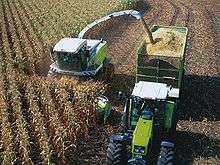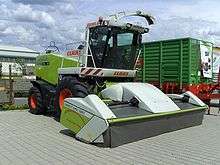Claas
|
| |
| GmbH & Co. KGaA | |
| Industry | Agricultural machinery, Agriculture |
| Founded | 1913 |
| Headquarters | Harsewinkel, Germany |
Area served | worldwide |
Key people | Strategy and Corporate Communications, speaker of the executive board |
| Revenue |
|
Number of employees | 10,961 (2017) |
| Website | www.claas.com |





Claas is an agricultural machinery manufacturer founded in 1913, based in Harsewinkel, Ostwestfalen-Lippe, Germany, in the state of North Rhine Westphalia. The product range includes combine harvesters, forage harvesters, balers, mowers, rakes, tractors, tedders and other harvesting machines. Claas produced its 450,000th machine in 2013.
History
Claas was created in 1913[2] when August Claas developed the company in Clarholz, Germany. In 1919, the business was transferred to Harsewinkel, Germany, where the company focused on the production of reapers. Two years later the company obtained their first patent – for a knotter to efficiently bind straw. The first Harvester was developed with the European market in mind in 1930, with the first Pick-up Baler following in 1934. In 1936 Claas started to market the first combine harvester built in Europe, as opposed to imported machines previously available. They then offered trailed combine harvesters to the European market.
Following the war in 1946, Claas introduced self-propelled combine harvesters. By the mid 1950s they opened a new factory in Paderborn, Germany, and their first outside Germany – in Metz, France in 1961. Claas took over Josef Bautz (agricultural machinery factory) and in 1969, expanded the product range to include green harvest machinery.
Modern era 1970s
In 1971, Claas was involved in the development of a pick-up sugar cane harvester. Then, two years later, in 1973, it presented the first self-propelled forage harvester. Three years later, in 1976 it introduced the first Claas round baler ROLLANT, followed by the introduction of the JAGUAR self-propelled forage harvesters seven years later in 1983. That was quickly followed by the presentation of QUADRANT in 1988 and then Agrocom, a computer based, satellite-assisted, agricultural information system in 1994. In 1995, Claas, in a joint partnership with Caterpillar introduced the LEXION combine.
Since 2000
Claas Omaha opened up in 2001 and began production on the LEXION combine series. Not long after, Caterpillar sells its 50% stake in the venture to Claas. However, North American LEXION combines continue to be distributed by Caterpillar dealers. Claas begins acquire Renault Agriculture in 2003, along with expanding its product range with tractors. Claas later opened up a new factory in Krasnodar, Russia in 2005, which is then followed by the launch of the AXION tractor (2006) and TUCANO combine (2007). Claas finishes acquiring the remaining stake of Renault Agriculture, making it fully owned by Claas. Then, in 2011, the LEXION 770 sets a Guinness World Record with 675.84 tonnes of grain harvested in eight hours.[3] Then, two years later, at the end of 2013, Claas' AXION 850 wins tractor and machine of the year 2014 at the Agritechnica show in Germany.
In Argentina
The local subsidiary has existed since 2001 - although in 1993, Reynaldo Postacchini, had imported a CLAAS model Mega 208 -, and is part of the list of 27 branches that the German company has around the world.
In 2006 the possibility that Claas Argentina set up a factory in Argentina was tangible and by 2013, began to produce the Tucano combine, with a motor of 270 to 360 HP (Class VI or VIII). At the same time, the company advances in the increase of the assembly capacity and a greater participation of the national pieces in its integration.
In the town of Ameghino (Buenos Aires), it manufactures heads and other equipment and components.
At present, the administrative headquarters of Claas is in the locality santafesina of Sunchales, department Castellanos.
Models produced: Claas Tucano 570[4] / Claas Tucano 470[5] / Claas Tucano 560[6]
References
- ↑ "Annual Report - Statistics". CLAAS Group. Retrieved 13 July 2018.
- ↑ http://www.claas-group.com/cc/servlet/generator/cl-gr/en/company/history/milestones/start,bpSite=35108.html Archived 2013-08-13 at the Wayback Machine.
- ↑ "Combine Harvesting (Wheat) - Team in Eight Hours". Guinness World Records. Guinness World Records. Retrieved 10 August 2013.
- ↑ http://pesadosargentinos.blogspot.com.ar/2015/11/claas-tucano-570.html
- ↑ http://pesadosargentinos.blogspot.com.ar/2014/12/claas-tucano-470.html
- ↑ http://pesadosargentinos.blogspot.com.ar/2016/06/claas-tucano-560.html
External links
![]()